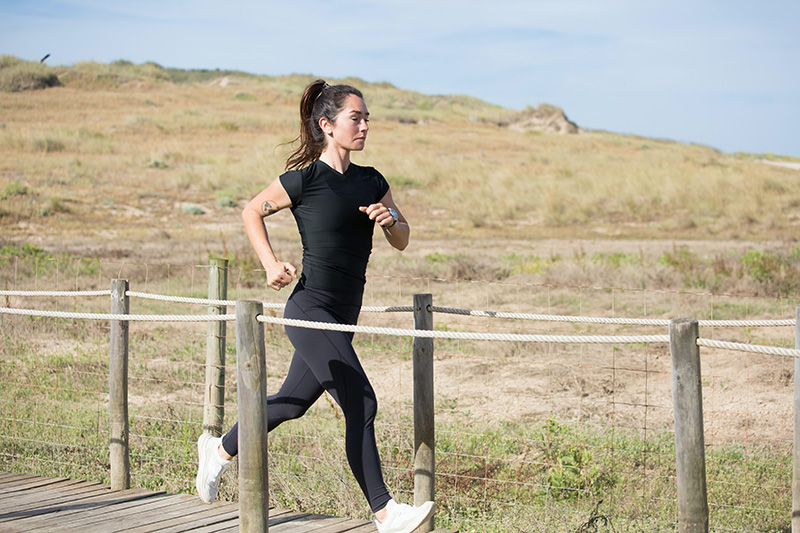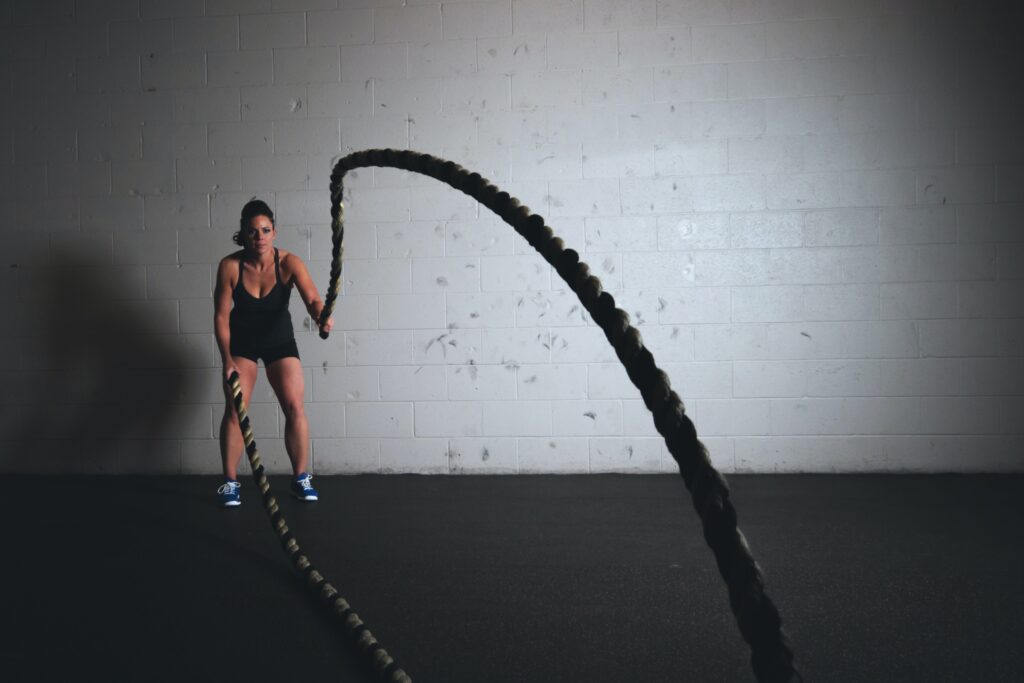Basic info about cardio exercise
Cardio exercises increase heart rate, these types of exercises involve repetitive movements which engage large muscle groups in your body. Your respiratory system is going to work harder as you begin to breathe deeply and faster. Your blood vessels will expand to bring more oxygen to your muscles and your body will release the stress-free chemical hormone endorphin. Cardio is a great solution for burning fat and losing weight.
The main advantages of cardio
This type of exercise will give you a vast spectrum of benefits. It is great for overall mental and physical health. No matter your age, weight, and athletic performance aerobic activities are great for you. Regularly incorporating cardio into your daily routine will get you stronger and more endurable. Other advantages include:
- Cardiovascular exercises are training the most important muscle in your body-heart. Cardio workouts will improve blood pumping and circulation through your entire body. It also reduces the risk of high blood pressure(hypertension) by lowering and stabilizing it.
- Regulating blood sugar is also one of the positive sides of aerobic workouts.
- Increases your stamina fitness and strength
- Combined with healthy diet habits, burns calories and fat.
- Reduces chronic pain
- Improves your mood
- Have a positive impact on your immune system
- Improves your brain functioning
- Increasing lung capacity
- You will have more quality sleep.
Choosing the right cardio exercise for you

There is a vast spectrum of cardio exercises out there. It all depends on your fitness goals, overall physical condition, and the activity you enjoy the most. Some people prefer outdoor cardio like running, jogging, cycling, or walking. Others will pick indoor cardio activities on treadmills, stationary bikes, rowing machines, or climbers. The most important is that you find that activity enjoyable so it’s entirely up to you. If you dislike gyms you can always do cardio exercises at home, like jumping jacks, jumping rope, jogging in the place, or burpees.
Frequency of cardio workouts
This is a commonly asked question, word frequency as you know, is determining how often we are doing some kind of activity in this case cardio. The general recommendation of the American Heart Association is to perform 30 minutes of cardio-vascular exercises 5 to 7 days a week. A big role also plays in your overall fitness condition, goals, and your daily schedule. If you are a beginner and you want to be healthier and you are not so focused on losing weight, exercising a little bit every day can do some good.
After frequency, you might also want to consider the intensity of the cardio workouts, and how hard you work. Depending on the intensity of the workout there are three major categories:
- Low-intensity Cardio
- Moderate-Intensity Cardio
- High- Intensity Cardio
The goals of cardio workouts are all also different, to maintain a healthy body weight you need 150 to 300 minutes of moderate-intensity cardio.
For overall health, you should try moderately-intense cardio for 30 minutes a day 5 days a week, or highly intensive cardio for 20 minutes a day, 3 days per week.
For weight loss and to avoid the yo-yo effect (regaining weight) you should do more than 300 minutes of moderate-intensity activity to achieve your goals.
Types of cardiovascular training

Various types of cardio training can help you to achieve your fitness goals and they are different. Someone just wants to lose weight and burn calories, others will aim for longer endurance and better athletic performance. Today we distinguish a couple of different types of cardio workouts, and the main difference between them is how much your heart is challenged during exercise.
- Low-intensity, long duration
This type of cardio training is beginner-friendly, it is a good option for fat loss, especially for obese people and it is the least challenging form of aerobic training. Applying this form of workout means that you’ll be using only 40 to 60 % of your maximum heart rate. Fundamentally it means conducting something slow, easy, and continuous for a longer period (about 40 minutes). You should be able to talk without any problem or discomfort during this kind of activity.
- Medium intensity, medium duration
This is a more advanced type of aerobic workout since you’ll be using approximately 70 % of your heart rate. You will be probably breathing heavier and it would be more difficult to talk or sing. Therefore it can’t be done for a long period, only between 20 and 40 minutes. This type of training can be used for increased aerobic capacity and fat loss.
- High intensity, short duration
This is the most demanding type of training since you’ll be using around 80 to 85% of your heart rate. You will be breathing heavily without the possibility to talk or sing. This high-intensity workout can’t last for long, only between 5 to 20 minutes, depending on your overall fitness level, genetics, and goals.
This type of workout is a simple and effective way to burn calories and increase the chance of weight loss, saving your time and effort in a gym. The most efficient use of this training is to add it to your regular cardio workouts. You’ll use short, extra-intense bursts of exercises throughout your regular cardio routine. When your body is pushed to work harder for a shorter period, it will increase the rate of fat burning.
For example, you can add one minute of an effective sprint to your regular 30 or 40 minutes cardio activity. (like walking or light jogging)
Anaerobic interval training

The point of this training is to push yourself as hard as you can for short periods, then rest equal or longer periods and all of that has to be done at 80-85% of your heart rate. Let me give you an example:
- Sprint as hard as you possibly can for 30 seconds
- Walk for 30 seconds
- Sprint for 30 seconds
- Walk for 30 seconds
- Repeat this tempo 3 to 6 times depending on fitness level.
Circuit training

Is a type of workout that involves endurance training, resistance training, and high-intensity aerobics. You won’t be bored with this circuit workout, that’s for sure since you have to pass 5-10 exercise circles and try to hit every muscle group in your body with minimal rest between each movement. It is a great way to change your workout routine and save time in the gym. The benefits of this training are huge, you will be able to boost your stamina, burn calories more efficiently, and stay more focused on training since you have minimal time between exercises.
Your body goes through a post-workout recovery period that requires more energy when performing circuit workouts than other training methods, so you’ll be able to burn 8 to 15% more calories on average than during other types of steady-state routines. The bottom line is that circuit training combines strength training movements and cardio, so you can expect to gain some muscle size and burn fat simultaneously.
One of the advantages of this training is that you can adjust it according to your overall fitness condition and goals. First, you need to determine a period
for a workout, then chose upper body exercise, then lower body exercise, after that one compound exercise, and at the end add one minute of max effort cardio. Here is an example :
- Set-ups for 60 seconds(rest 15-30seconds)
- Bent Over Row for 60 seconds (rest 15-30 seconds)
- Bodyweight squats for 60 seconds (rest 15-30 seconds)
- Shoulder press for 60 seconds (rest 15-30 seconds)
- Jumping jacks for 60 seconds (rest 15-30 seconds)
- Romanian deadlift for 60 seconds (rest 15-30 seconds)
- Push-ups for 60 seconds (rest 15-30 seconds)
- Glute bridges for 60 seconds(rest 15-30 seconds)
- Plank for 60 seconds.
Cardio vs strength training for weight loss
Everyone who planned to lose weight at some point will certainly ask this question. Both exercises are beneficial for weight loss, and overall very popular workouts, but which one is superior for losing weight?
Cardio-vascular workouts as you know will put your cardiovascular and respiratory system to the test, or other words your lung and heart capacities will be challenged. You should be able to burn more calories while your heart rate is elevated.
If you are aiming to lose weight your goal should be burning more calories and building muscle mass. A cardio workout can help you in burning calories, the more you exercise, the more calories you’ll burn. For weight loss, you should perform cardio activities at least five days a week. That is roughly 250 minutes of cardio weekly.
Cardio will have the upper hand over strength training in calories burned per training session weight-lifting. How many calories you’ll burn depends on your body size, the intensity of your cardio workout, and your overall health condition. (read more)
Strength training uses resistance to build muscle, by term resistance I refer to barbells, dumbbells, weighted machines, and even your body weight. This type of training has numerous advantages. You should be able to boost your strength, and endurance and stimulate fat loss. Building more muscle will speed up your metabolism and burn more fat while you exercise. The main recipe for weight loss is to burn more calories than you intake. Increasing the calories you burn will help you to lose weight.
Another benefit of a strength workout is that you burn more calories hours after training. Your metabolism can stay elevated for up to 48 hours after heavy-weight training, while such an increase you can’t expect with cardio. You can do aerobic exercises seven days a week, but there is no way you can apply this to your strength training. For maximizing the results you should incorporate strength training into your routine 3-5 times a week. Unlike cardio, you shouldn’t do strength training every day. While aerobic exercises you can do seven days per week.
For maximum fat loss and building muscle mass, the best way is to include both of these routines[1] into your workout program. If you are new to training you can find many fitness programs or apps for free on the internet, but if you feel unsecured or confused you can always invest in the service of a personal trainer, who can make training and nutrition plans specialized for your needs.
You have to be consistent and stick to the training program as well as your diet plan. If you want to lose weight you have to be in a calorie deficit, to consume low-calorie but highly nutritious foods that contain protein and fiber. Make sure you fill your plate with vegetables, fruits, whole grains, and lean protein. This should be the essence of a well-balanced diet, regardless if you are training or not. (read more)
Which cardio exercise is the most effective?

As previously said if you are just starting to exercise, you should choose the activity you enjoy the most, but as you advance you want to consider physical activities that burn the most amount of calories in the least amount the time. This is a good way to maximize your effort and save time spent exercising. Now let me present you a list of cardio activities and calories burned during 30 minutes of training:
- Hiking 185 calories
- Dancing 165 calories
- Walking 145 calories
- Running (5mph) 295 calories
- Swimming 295 calories
These activities are recruiting major muscle groups in your body and they can be very challenging and demanding at moderate or high intensity.
Conclusion:
Cardiovascular exercise has been long known as the cornerstone of any effective fitness program and the key to living a longer, more joyful life. Health benefits are numerous. Combined with strength training cardio will help you to reduce body fat and stay lean. You don’t even have to leave your home to do some cardio exercises. Stay consistent and follow your diet plan and results will be reflected in the mirror.
Source:






